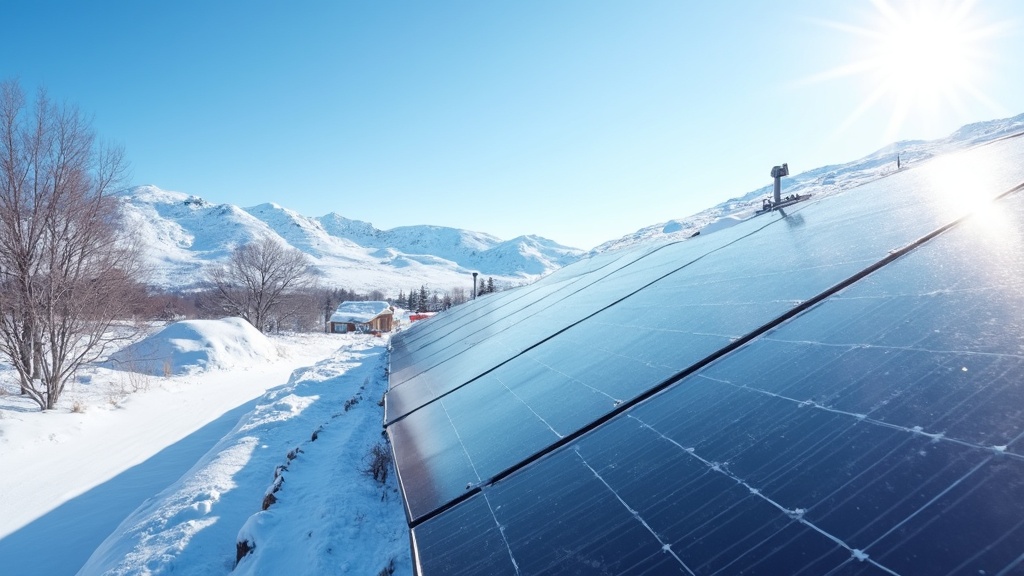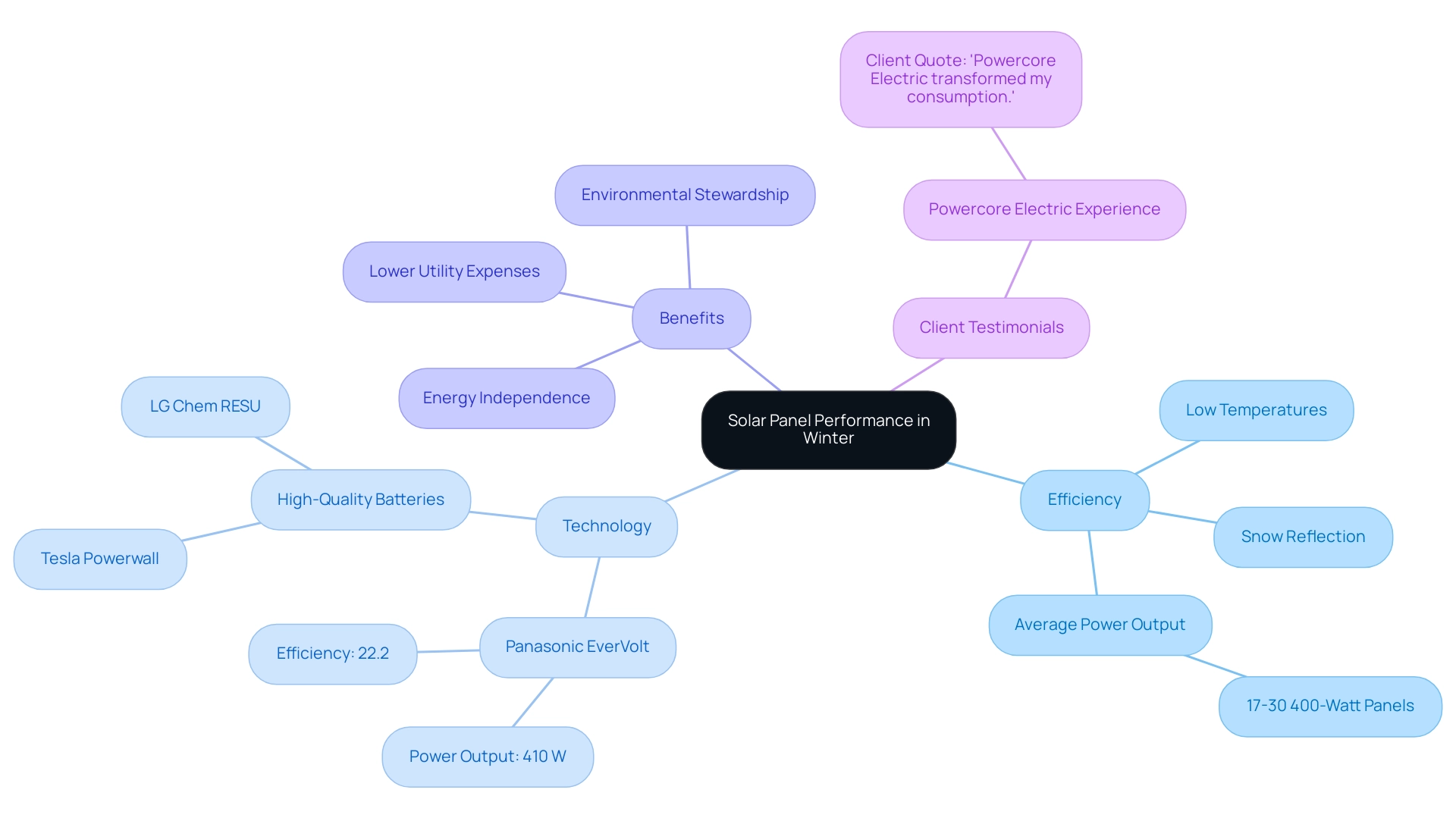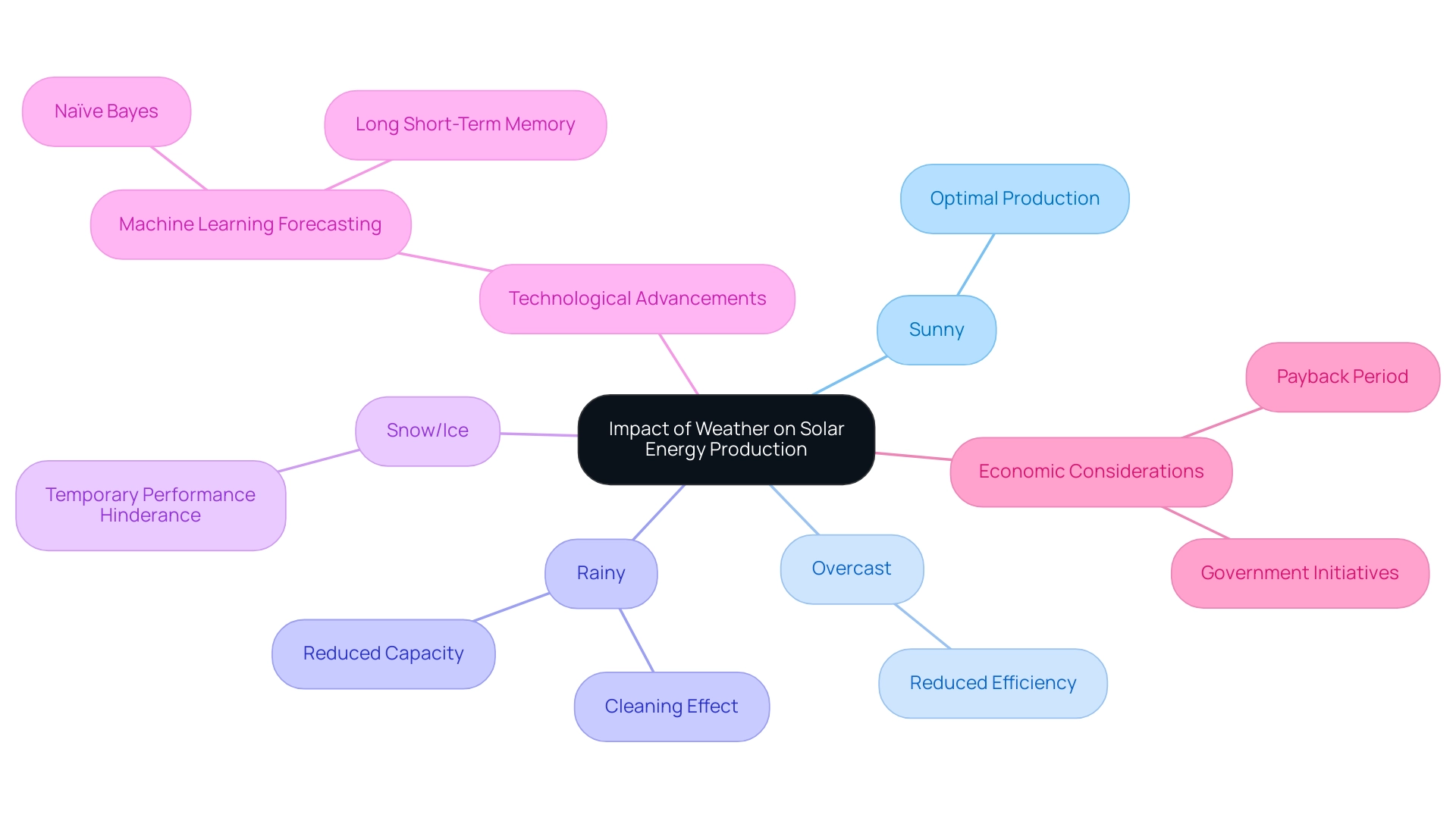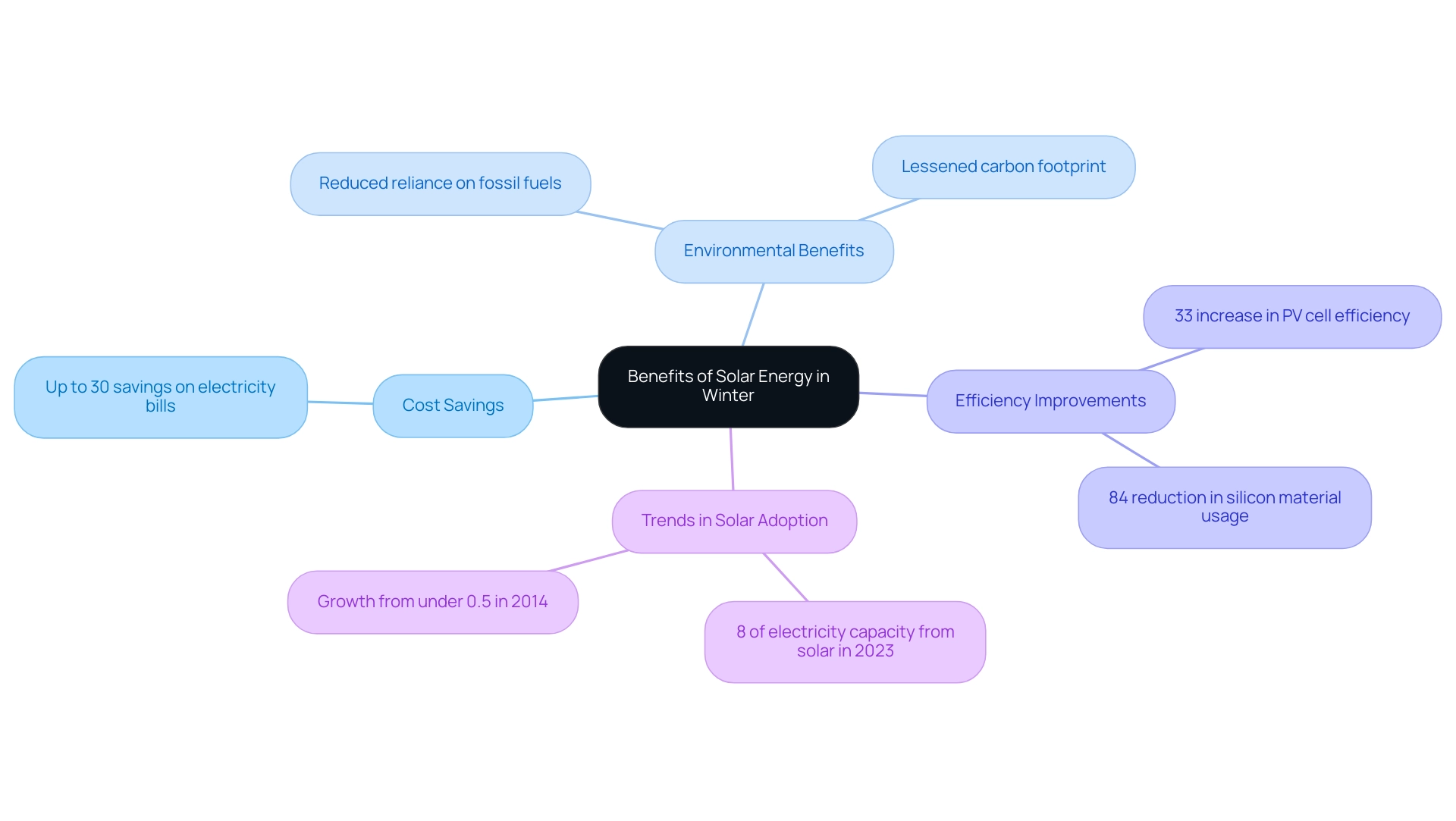Overview
Solar panels do work effectively in winter, as they can maintain impressive efficiency due to low temperatures enhancing their performance, despite shorter days and potential cloud cover. The article supports this by explaining that photovoltaic cells can produce more electricity in cold conditions, and even snow can improve energy capture through reflection, demonstrating that winter is a viable season for solar energy generation.
Introduction
As winter blankets the landscape, many homeowners wonder if their solar panels can still deliver the energy they need. The good news is that solar panels are not only capable of functioning in colder weather, but they can also thrive! While shorter days and cloudier skies may seem daunting, the chill of winter can actually enhance the efficiency of solar cells, allowing them to generate impressive amounts of electricity.
From the surprising benefits of snow to practical tips for maintenance, this article delves into the performance of solar energy systems during winter months. It also addresses common misconceptions and highlights the financial and environmental advantages of embracing solar power year-round.
Whether you’re considering a solar installation or looking to optimize your existing system, understanding how solar works in winter is key to maximizing your energy independence and sustainability.
Do Solar Panels Work in Winter? Understanding Their Performance
Certainly, photovoltaic systems are designed to function efficiently with solar in the winter! You might be surprised to learn that they can maintain impressive efficiency with solar in the winter, even during colder weather. The crucial element here is sunlight—solar collectors convert sunlight into electricity, and while solar in the winter can bring shorter days and sometimes cloudier skies, the cold itself can actually enhance performance.
- Low temperatures enhance the efficiency of photovoltaic cells, enabling them to produce more electricity from solar in the winter than in warmer conditions.
- In fact, with 17-30 400-watt modules, an average U.S. home can be powered, showcasing the capacity and efficiency of photovoltaic systems.
- While snow might cover your panels temporarily, it often melts quickly due to the heat produced by the panels themselves.
Interestingly, the reflective quality of fresh snow can improve power capture, thereby making solar in the winter a unique opportunity for generating electricity. A notable example is the Panasonic EverVolt HK Black Series model, which delivers a power output of 410 W with an efficiency of 22.2%, demonstrating reliable performance for solar in the winter.
To maximize the advantages of sunlight, pairing your system with high-quality batteries, such as the Tesla Powerwall or LG Chem RESU, is essential for efficient power storage. These batteries not only store excess power generated during sunny days but also ensure that you have power available during the night or cloudy days, enhancing your independence.
Additionally, the recent rise in imports of monocrystalline silicon cells highlights the advancements in solar technology, enhancing the significance of solar solutions throughout the year. At Powercore Electric, we’re motivated by a dedication to sustainability and local knowledge, ensuring that our solutions not only lower your utility expenses but also encourage independence and environmental stewardship.
As one pleased client remarked, ‘Powercore Electric transformed my consumption, making my home more efficient and eco-friendly.’ This spirit of community and innovation is what makes embracing renewable energy in all seasons so rewarding.
Maximizing Solar Efficiency in Winter: Tips and Best Practices
To ensure your solar in the winter systems are functioning optimally during the winter months, here are some friendly tips to keep in mind. First and foremost, cleanliness is key. Make it a habit to check your panels for snow and debris—removing any accumulation with a broom or soft brush will help keep them in tip-top shape without risking damage.
Remember, a clean surface is vital for optimal energy production, as dirt and snow can block sunlight and hinder performance. Next, monitor your system’s performance regularly. Many contemporary energy systems come equipped with handy monitoring apps that can alert you if production dips unexpectedly, so you can take action right away.
Furthermore, the position of your surfaces can greatly influence the amount of sunlight they collect during the low season sun. If your system is ground-mounted, consider adjusting the tilt to maximize exposure. It’s also important to examine your panels for damage, particularly after winter storms.
As Matt Piantedosi notes, “Water ingress frozen inside an electrical enclosure” can lead to serious issues if not addressed promptly. Furthermore, consider investing in a battery storage system for renewable energy. This smart addition allows you to store energy produced on sunny days for use during cloudy weather or nighttime, ensuring a steady energy supply even when the sun isn’t shining brightly.
Lastly, advancements in coatings and treatments, as highlighted in the Factory-Finish Coating Technologies case study, are being developed to facilitate automatic snow and ice removal from PV systems, which may improve maintenance efficiency in the future. Routine maintenance frequency may vary based on your location, as some areas require more regular attention to dust and debris buildup. Interestingly, researchers from the Indian Institute of Engineering Science and Technology have developed a model to estimate dust accumulation on photovoltaic panels, which can help you determine when cleaning is necessary.
By following these best practices and embracing innovative solutions, you’ll be set up for success in maximizing your energy efficiency with solar in the winter while contributing to a more sustainable home!
The Impact of Weather Conditions on Solar Energy Production
Weather conditions significantly impact sunlight generation, and it’s crucial for eco-conscious homeowners to comprehend this dynamic. While sunny days are certainly the best for optimizing power production, it’s a widespread misunderstanding that photovoltaic systems become inefficient during overcast or rainy conditions. In reality, photovoltaic panels can still produce power under overcast skies, though typically at a reduced capacity.
Interestingly, rain can actually benefit your energy system by washing away dust and debris, which can enhance efficiency and reduce the need for eco-friendly cleaning options. However, it’s important to note that extreme weather conditions like heavy snow or ice storms can temporarily hinder performance. In a study conducted on a rooftop power generation facility located in Bhubaneswar, India, the payback period was calculated based on various weather conditions, providing valuable insights into the economic viability of energy systems.
Furthermore, research utilizing machine learning algorithms, such as Naïve Bayes and Long Short-Term Memory networks, has shown how accurate forecasting of power generation can be improved by analyzing historical weather data. As Manajit Sengupta, Chief Scientist of Sensing and Predictive Analytics at NREL, states, ‘The data is utilized by nearly all plant developers in the U.S., Canada, Mexico, and Central and South America to evaluate resource needs while creating new projects.’
As you assess your renewable power system’s output during the winter months, consider the impact of solar in the winter.
Understanding how your system functions in various weather conditions, particularly solar in the winter, aids you in making informed choices, optimizing your home’s power generation, and selecting the best battery options for effective power storage, such as lithium-ion batteries recognized for their high efficiency and durability. Furthermore, investigating government initiatives can offer financial benefits for your renewable investments, and evaluating Tesla Home Chargers can improve your power management system. This comprehensive method ensures you maximize both power production and storage efficiency.
Common Misconceptions About Solar Energy in Winter
Many homeowners grapple with misconceptions about solar in the winter, leading to unnecessary confusion. One common misconception is that photovoltaic modules are ineffective in cold or overcast conditions. In reality, today’s photovoltaic systems can generate approximately 10% more electricity than those created just five years ago, meaning they can still function effectively even when the sun isn’t shining brightly.
Furthermore, as per the U.S. Energy Information Administration, residential renewable energy installations across the US increased by 34% from 2.9 gigawatts in 2020 to 3.9 gigawatts in 2021, highlighting a growing trend towards adoption among homeowners. Another prevalent misconception is that snow can entirely prevent photovoltaic systems from functioning. However, snow often slides off the panels due to their angle and residual heat, allowing sunlight to penetrate even through thin layers.
By debunking these myths, homeowners can gain a clearer understanding of how their energy systems can continue to generate solar in the winter. At Powercore Electric, we take pride in our community knowledge and unparalleled quality workmanship, ensuring that your installation not only meets the highest standards but also aligns with your sustainable objectives. Our energy solutions are designed to outperform competitors, offering superior efficiency and reliability even in less-than-ideal weather conditions.
With our customer-first approach, we are here to assist you in navigating the winter months confidently, ensuring you maximize your investment in solar in the winter while minimizing your carbon footprint.
The Benefits of Solar Energy in Winter
Winter may present its own set of challenges, but the advantages of harnessing solar in the winter are truly noteworthy for eco-conscious homeowners. By generating their own power, homeowners can significantly cut down on electricity bills—potentially saving up to 30% on their monthly utility costs—and reduce their reliance on the grid. In 2023, electricity generation from sunlight peaked in July at 26,626 GWh, showcasing the seasonal variations in production.
This shift not only leads to tangible savings but also fosters a more sustainable lifestyle, reducing dependency on fossil fuels and lessening carbon footprints. As noted by the Fraunhofer-Gesellschaft, the average efficiency of photovoltaic cells in commercial panels has increased by 33% over the past decade, while the amount of material used for silicon cells dropped by 84% over the past 16 years. Additionally, numerous utility providers are increasing efforts to provide financial incentives for renewable power generation, enhancing the monetary benefits for homeowners.
With utility-scale photovoltaic systems representing approximately 8% of the nation’s electricity capacity in 2023—a substantial rise from under 0.5% in 2014—the increasing influence of renewable power on the electricity grid underscores the viability of solar in the winter. By utilizing solar in the winter, homeowners can enjoy both cost savings and ecological advantages, aiding in a more sustainable future. To explore how you can make the switch and enjoy these advantages, contact us today for your free, personalized estimate from Powercore Electric.
Together, we can ensure your home is powered by sustainable resources, maximizing your savings and promoting power independence. Join the many satisfied customers who have made the switch and are enjoying the benefits of solar energy!
Conclusion
Understanding how solar panels perform in winter opens up a world of possibilities for homeowners eager to embrace renewable energy year-round. While many may worry about shorter days and colder temperatures, the reality is that solar panels are designed to operate efficiently in winter conditions. They can even generate more electricity in the cold, and snow can serve as an unexpected ally by enhancing sunlight capture.
To maximize solar efficiency during the winter months, a few simple practices can make a significant difference:
- Regularly clearing snow and debris
- Adjusting panel angles
- Investing in battery storage
These are all proactive steps that can enhance energy production and ensure a reliable power supply. By staying informed about weather impacts and maintaining your system, homeowners can navigate winter challenges with confidence.
Debunking common myths about solar energy is essential for encouraging more homeowners to invest in this sustainable solution. With advancements in technology and the increasing efficiency of solar panels, there is no reason to believe that winter can hinder energy production. Instead, it’s an opportunity to harness clean power and reduce reliance on the grid.
Ultimately, embracing solar energy in winter not only leads to potential savings on utility bills but also contributes to a more sustainable future. With financial incentives and a growing trend towards solar adoption, now is the perfect time to explore the benefits of solar power. By taking action, homeowners can enjoy the advantages of renewable energy while playing their part in creating a cleaner, greener planet.





